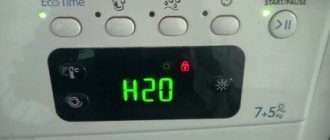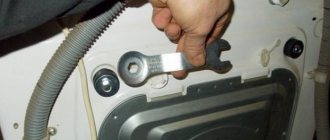The advent of washing machines has greatly simplified the life of any housewife. But, like any other household appliance, these miracle devices tend to break. Turning to professional craftsmen is not always affordable, and then the problem arises: what to do if the washing machine does not heat the water when washing.
It is better to entrust the repair of a washing machine to professionals, for example, the ob-service.ru service offers to repair a washing machine with such faults from only 1000 rubles.
Determining if there is a problem
Before you panic and try to solve the problem, you need to find out if this problem even exists. First of all, you need to pay attention to the selected washing mode. Some brands of machines, for example, Indesit or Samsung, do not heat water in delicate modes, washing silk or sports shoes.
If the mode involves heating, then you need to pay attention to whether it is set correctly.
Certain models of machines, for example LG, have two regulators for setting the mode and temperature. The data of these regulators must strictly comply with the program specified in the instructions. If the specified temperature does not correspond to the mode, then the machine simply does not heat the water. All data is indicated in the instructions, so you need to read it very carefully.
If the selected temperature and mode correspond to each other, and the unit is supposed to heat water, then you should check whether it really does not do this. Some believe that the signal that the device fails to heat water is when the clothes are cool at the end of the wash, but this is not so. The fact is that the rinsing, which is performed by the machine after the wash itself, occurs only in cold water, and therefore the laundry can be cold.
You can find out if the washing machine is not heating the water properly as follows:
- Start the wash at a temperature of about 60 degrees (this is enough, although you can choose any other mode with warm water).
- After 20-30 minutes, touch the drum glass with your hand.
- If the glass is still cold, then the water in the washing machine is not really heating up.
Please note that you need to touch the glass very carefully; heated glass can cause you to get burned.
If the problem of the water not heating during washing exists, then the next step is to find the location of the problem.
Let's test the heating element
When there are problems with heating water, the first suspicion always falls on the heating element. This is logical, so it is recommended to start diagnostics with it. To get to the heater, you need to disconnect the washing machine from the power supply and water supply, move it away from the wall and turn the back panel forward. Next, unscrew the screws holding the “back”, remove it and look for the element. It is located in the lower part of the body directly under the drum.
Having removed the panel, it is easy to find the round “chip” of the heating element, as well as the thermistor and the wiring connected to them. However, you will first have to remove the drive belt from the pulley to ensure free access to the heater. Afterwards we photograph the location of all connections and proceed to diagnostics:
- disconnect the connected wiring;
- switch the multimeter to the “Resistance” mode and set it to “200 Ohm”;
- We bring the probes to the terminals of the heating element;
- We evaluate the indicators.
A working heating element displays a value of at least 26 Ohms, maximum - 28 Ohms. If the device outputs “1” instead of the norm, then the heater was damaged due to an internal winding break. A result of “0” will indicate a short circuit has occurred. In the extreme two cases, it will not be possible to repair the element - replacement is necessary.
The next step is to check the housing for breakdown. We switch the tester to buzzer mode and apply the probes. If a squeak is heard upon contact, it means that a current leak has been detected - you will have to change the heating element.
The heating element is easy to change. It is enough to dismantle the old device by loosening the central nut and disconnecting the thermistor. Difficulties arise when the existing rubber gasket becomes deformed, increases in size and “blocks” the heater. In this case it is necessary:
- generously lubricate the cuff with WD-40;
- wait 15-20 minutes;
- collect remaining lubricant;
- swing the heater and pull it out of its seat.
When replacing, it is important to choose the right analogue. The main reference point will be the markings stamped on the heater body
The serial number of your existing Atlanta will also help. It’s even better to bring the dismantled heating element to the store and find a replacement on the spot. Before installing a new heater, it is recommended to thoroughly clean the seat from dirt and scale. The machine is assembled according to the instructions described earlier, only in reverse order.
Possible locations of the problem
Some machines, especially models with automatic self-diagnosis, if they do not heat the water, then immediately refuse to work. While their more responsible brothers continue to perform their main function - washing clothes, albeit in cold water.
If a machine that does not heat the water still continues to wash, this does not mean that the problem does not need to be solved.
The fact is that such incorrect operation can lead to more serious damage. Incorrect operation of the device may be the result of failure of some parts:
- Failures in the sensor that monitors the water level (then the machine believes that there is not enough water yet and it is too early to heat it).
- The wires leading to the heating element are damaged (the circuit is not closed, the heating element does not work).
- Failure of the heating element itself (the heating element cannot heat the water due to its own malfunction).
- There is a failure in the sensor that monitors the temperature (the device simply does not understand when and to what temperature it needs to heat the contents).
- There is a breakdown in the control module assembly (the “brain” part of the device does not know what to do).
Each of these malfunctions explains why the washing machine cannot heat the water and the laundry does not wash.
How to fix a pressure switch
If the thermostat is working properly, the possible cause of the breakdown is a clogged pressure switch. Repair of this element is carried out as follows:
- disconnect the washing device from the power supply;
- remove the back wall or front part along with the control panel;
- visually assess the situation and inspect the pressure switch relay;
- remove the clamp and disconnect the tube;
- Blow and clean it thoroughly.
It is also recommended to check the pressure switch for leaks. If cleaning does not correct the situation, the part will need to be replaced. In order to choose the right new part in the store, you will need to dismantle the faulty element and take it with you. The consultant will help you choose an analogue.
Causes of failure
The reasons for the breakdown of these parts and the results of why the washing machine does not heat the contents may be as follows:
- The water level sensor tube is clogged (this can easily happen due to hairs, debris and pieces of thread from clothing getting into the machine).
- Chafing of wires due to vibrations during operation of the washing machine (in some models, the internal wires rub against the wall of the washing machine and when it rattles during operation, they fray).
- Scale can interfere with the normal operation of the heating element or temperature sensor (sometimes scale can simply interfere with heat transfer).
- Voltage surges in the electrical circuit (they can lead to burnout of elements).
- Manufacturing defect (most often the cause of control module failure).
Replacing the temperature sensor
If the temperature sensor or thermostat fails, the washing machine either begins to bring the water to a boil or refuses to heat it at all. The performance of this element is also determined by a multimeter. In the washing device, the temperature sensor is located near the heating element.
The thermistor is replaced as follows:
- open the back panel of the washing machine;
- disconnect the wiring connector from the temperature sensor;
- carefully remove the sensor from the mounting socket;
- put a new thermistor in its place and attach a connector with wires to it.
See also
Rules for do-it-yourself installation of slopes from sandwich panels and how to finish them
In some models, such as Indesit washing machines, the sensor is located in the heater. In order to remove the element, you will need to loosen the fasteners of the heating element. You can replace the part yourself, however, to eliminate possible problems, it is recommended to use the services of specialists.
Diagnosis of the problem
If the washing machine cannot heat the water, then you need to diagnose those spare parts whose failure prevents the water from heating. Diagnostics includes a visual inspection or the following actions aimed at identifying the problem:
- Inspect the water level sensor tube.
- Visual inspection of internal wiring.
- Visual inspection of the heating element for the presence of scale.
- Checking the performance of the heating element using a multimeter (measure the resistance of the device, heat the heating element and measure the resistance again, compare the indicators, and if they are almost the same, then the element has burned out).
- Checking the temperature sensor (check the operation of the machine with forced heating, if such a function is available).
Washing machine heating errors by brand
Depending on the brand of washing machine, error codes may be as follows:
- Bosch – F19, F22
- Indesit – F03, F08
- Haier - error 4
- LG -
- Siemens – F06, F07, F19, F22
- Samsung – H1, H2, HE, HE1, HE2, E5, E6, NS, NS1, NS2, tE / Ec / tC
- Ariston and Hotpoint-Ariston – F03, F08
- Candy – E05, E14, E16
- Atlant –
- Electrolux – E03, E61, E62, E66, E68, E69, E3A, E71
- Whirlpool – F08
Why did the machine stop heating water and what should I do? Let's look further.
Debugg
After identifying a malfunction resulting in the washing machine not heating the water, you need to fix it. You can do this as follows:
- Clean or replace the water level sensor tube.
- Replace or solder and insulate damaged wires.
- Remove scale from the heating element by boiling it in water with citric acid.
- Replace the heating element with a new one.
- Replace the temperature sensor.
- Replace or repair the control module.
It is better to entrust the replacement of the control module to professionals, and in some cases simply purchase a new device, since the replacement procedure can be more expensive.
If the water in the washing machine does not heat up, you need to find the cause of the equipment malfunction and try to eliminate it. If difficulties arise, it is better to contact a repairman. And if the washing machine is under warranty, then contacting the service center is mandatory without attempting to fix the problem yourself.
Question answer
Why does water take so long to heat up?
Any part does not break immediately, it does so gradually. Most likely, your heating element is broken - a large amount of scale has formed on it. To descale the heating element, add water softener during washing.
How to determine that there is no heating?
To understand whether the machine heats the water, start the wash at a temperature of 40 degrees. After half an hour, place your palm on the glass of the hatch. If it's cold, there really is a problem.











